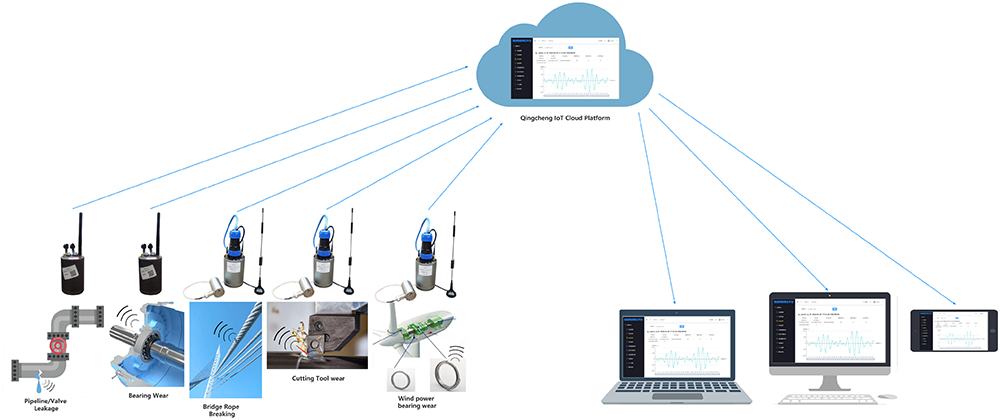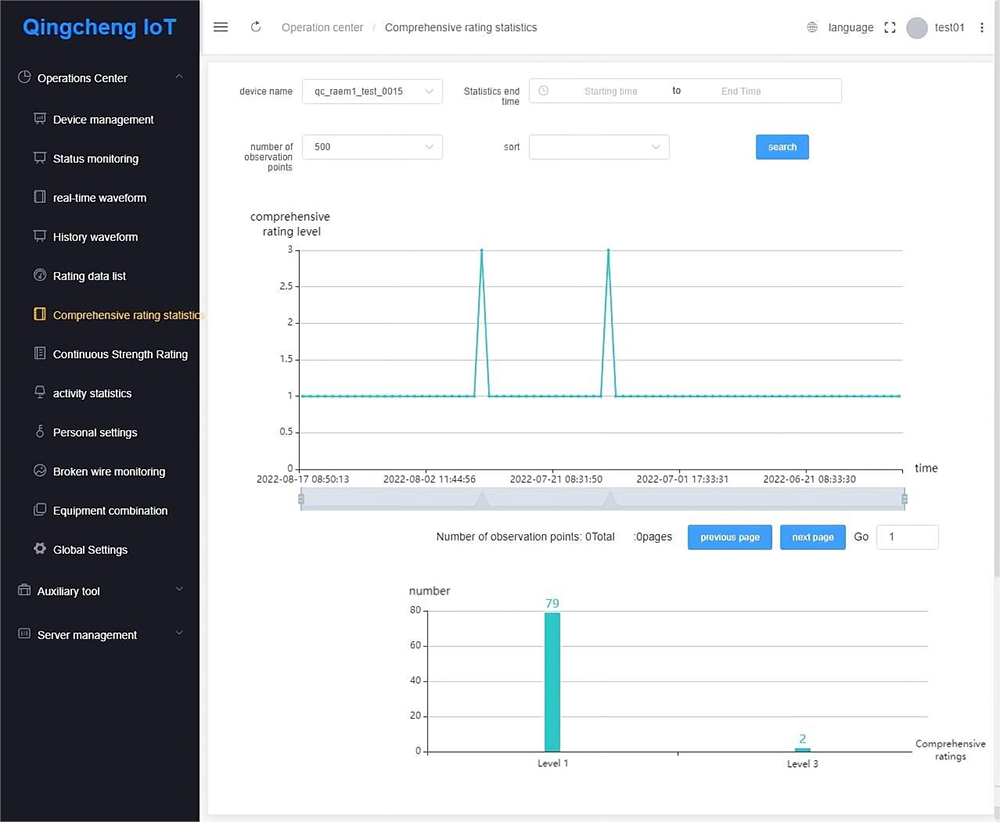Internet of Things Acoustic Emission Online Monitoring and Fault Diagnosis of Structures and Equipment
Jiehui Xie1), Yating Liu2) and Shifeng Liu3)
1) QingCheng AE Institute (Guangzhou) Co., Ltd., Guangzhou, Guangdong, 510670, China.
2) QingCheng AE Institute (Guangzhou) Co., Ltd., Guangzhou, Guangdong, 510670, China.
3) QingCheng AE Institute (Guangzhou) Co., Ltd., Guangzhou, Guangdong, 510670, China.
ABSTRACT: Online monitoring and fault diagnosis of various structures and equipment is a hot spot in industry, national defense, and national economy but also is the important technology in a huge demand. With the rapid development of the Internet of Things (IoT), the acoustic waves (acoustic emission) (AE) monitoring and diagnosis technology of the IoT is a new technology for the online monitoring and fault diagnosis of the above structures and devices, and has been successfully applied in a large number of applications, showing a strong and wide application prospect.1) QingCheng AE Institute (Guangzhou) Co., Ltd., Guangzhou, Guangdong, 510670, China.
2) QingCheng AE Institute (Guangzhou) Co., Ltd., Guangzhou, Guangdong, 510670, China.
3) QingCheng AE Institute (Guangzhou) Co., Ltd., Guangzhou, Guangdong, 510670, China.
1 The principle of acoustic emission technology in the Internet of Things
The Internet of Things Acoustic Emission (IoT-AE) is composed of acoustic emission sensors, acoustic emission data acquisition and analysis module (acquisition module), Internet communication module, cloud server, and client smartphone /PC. First of all, the acoustic emission sensor acquires AE signals from the monitoring objects (for example, tanks, pressure vessels, pipes, tank bottom valves, bridge wire ropes, wind-power blades, rotating machinery, cutting machines, etc.). The AE sensor transforms the tiny mechanical vibration signal into an electrical voltage signal, which is then transmitted to the acoustic emission data acquisition and analysis module for data processing. At present, the AE signal acquisition and processing methods can be divided into two categories: one is to represent the characteristics of AE signals by multiple simplified waveform characteristic parameters, and then analyze and process these waveform characteristic parameters. The other method is to store and record the waveform of acoustic emission signals and analyze the frequency spectrum of the waveform. Simplified waveform characteristic parameter analysis method is a classic acoustic emission signal analysis method that has been widely used since the 1950s. It is still widely used in acoustic emission detection applications, and almost all acoustic emission detection standards adopt the simplified waveform characteristic parameter for acoustic emission source criteria.IoT-AE was developed and introduced in terms of hardware, software, and network architecture. IoT-AE transmits data and analysis results to network servers through various in-network communications. The results of the analysis can be sent as an alarm message to end-users' smartphones and PCs. Users do not need an AE professional to operate IoT-AE system. Therefore, IoT-AE can be used as a remote long-term unattended monitoring and automatic alarm system. Compared with traditional AE instruments, which need to manually process data to get detection and monitoring results, IoT-AE system automatically controls data acquisition and analysis through the embedded software. In addition, the long-term self-learning correction cycle of AI on the server based on Big Data makes the system capable of self-learning, self-improvement and continuous performance improvement. The IoT-AE system adopts the simplified waveform characteristic parameters method. It extracts useful AE waveform and parameter information, and then outputs the results (alarm information, waveform and parameters). The output of the AE module is transmitted to the server/ smartphone/ PC via the Internet/Intranet communication modules.
This paper explains the principle of AE technology of the Internet of Things, which consists of three parts, smart acoustic emission devices, cloud network platform and user interfaces. The paper then introduces the application schemes and practical application cases using the newly developed smart AE monitoring and diagnosis equipment of the IoT.
2 Introduction to RAEM
2.1 Remote Acoustic Emission Monitoring (RAEM) System
RAEM (remote acoustic emission monitoring) system is an IoT-AE remote monitoring system developed by Qingcheng AE Institute (Guangzhou) Co., Ltd. The system mainly consists of three parts: RAEM (sensor, signal acquisition and analysis, communication), platforms (cloud server/LAN /PC/ mobile phone, etc.), and client terminals (mobile phones, PC, large screen, etc.). The AE signals are automatically collected, analyzed and processed by RAEM, and the processed results are sent to the platform through the communication network. Customers can view the acoustic emission waveform and parameters on different devices according to their needs, or the platform system actively pushes the preset alarm information to notify users.
Figure 1: The general structures and applications of RAEM

RAEM module is an intelligent single-channel acoustic emission collector integrating signal acquisition, signal analysis and communication. After the collected signal is digitized by AD, the FPGA and ARM of SoC start the frequency domain filtering, waveform processing, AE characteristic parameters extraction and parameters evaluations. The data is then transmitted to the IoT platform through the communication module built inside RAEM, for example 4G, WiFi and network cable.
The IoT platform can be Qingcheng IoT Cloud Platform developed by QingCheng company, or Alibaba Cloud, or Amazon Cloud Services, or even the clients’ own servers. On the well-configured cloud platform, data storage and data display of waveform and parameters can be achieved, as well as remote dual transmission and configurations of RAEM devices. It can also analyse and alarm of the intensity and activity levels of the acoustic emission events.
Client terminals can also be diverse, including computers, smart phones, industrial computers, servers, tablets and so on.
2.2 Automatic Acoustic Emission Data Rating Algorithm (Automatic Rating)
RAEM can automatically calculate and analyze the data ratings based on AE parameters to give intensity levels, activity levels and comprehensive ratings. In addition, the rating results are pushed to the users in the form of alarm messages according to the rating severity, so that the users do not need to conduct the complex and professional AE data analysis.The ratings and levels are based on the rules made by users. Users can select one or more desired parameters and their proper parameter values to specify the intensity levels. The intensity levels are defined by the number of occurrence of the intensity level triggering. For a certain sampling time, if the specific AE parameter values or times exceed a specified intensity level or activity level, it will be assessed as a certain intensity or activity level. Users can set the intensity or activity level trigger alarms, or push the alarm messages according to the comprehensive rating levels.
The comprehensive rating is the highest level of intensity and activity over a period of time, giving the highest level of the system performance evaluation. The comprehensive level conforms to NBT47013.9-2015 standards.

Figure 3: Qingcheng IoT platform comprehensive rating statistics
4 CONCLUSIONS
RAEM Internet of Things acoustic (acoustic emission) online monitoring system has been applied in somefields, such as bridge suspension wire breakage monitoring, valve pipeline leakage monitoring, pressure vessel crackmonitoring, tank bottom corrosion monitoring, and rotating machinery condition monitoring. Comparedwithother existing AE devices, the RAEM system has the advantages of flexible installation, wireless datatransmission, real-time cloud data display, wireless synchronization clock for locating AE sources, noneedforprofessional analysis of results, and automatic result rating reporting. However, RAEMstill has some shortcomings and can be improved. For example, when setting up for the first time, connection setupandconfigurations may not be straightforward enough. If the device is powered by batteries, it can only be usedforperiodic intermittent collection, and cannot be used for a quite long-term continuous collection. With the furtherdevelopment and promotion of the Internet of Things technology, the Internet of Things acoustic emissiontechnology is a big trend and has a great demand in the industry. As a product of acoustic emission in the Internet of Things, RAEM system is expected to be applied and promoted in more fields and cases while beingfurtherimproved.REFERENCES
[1] Xie, J., Wang, S., Liu, W., Yang, H., Zhang, L., Liu, S. (2021). “Internet of Things Acoustic Emission: Systems and Applications”. In: Shen, G., Zhang, J., Wu, Z. (eds) Advances in Acoustic Emission Technology. Springer Proceedings in Physics, vol 259. Springer, Singapore. https://doi.org/10.1007/978-981-15-9837-1_2.More details please click《IAES26_Liu_fullPaper》





